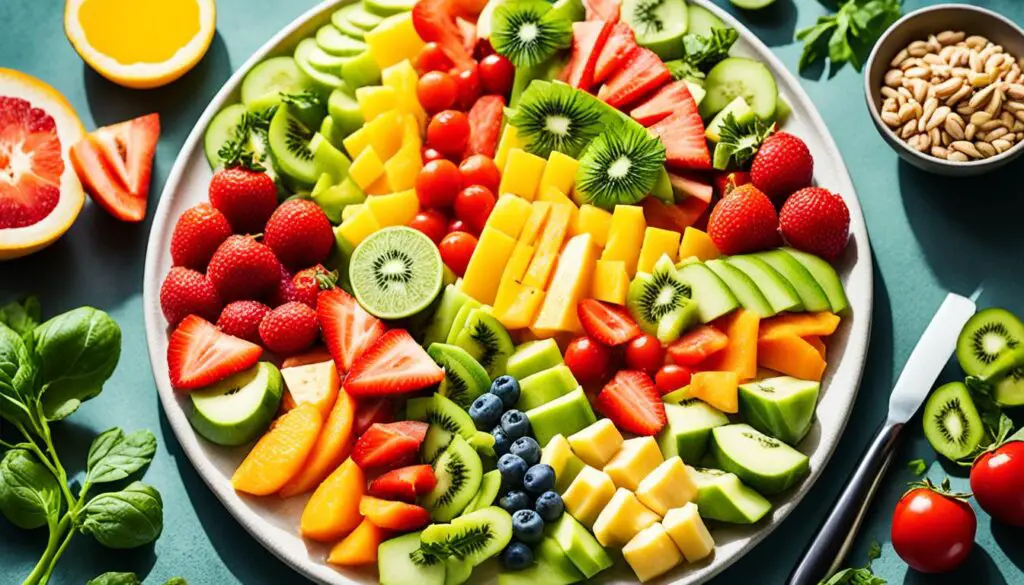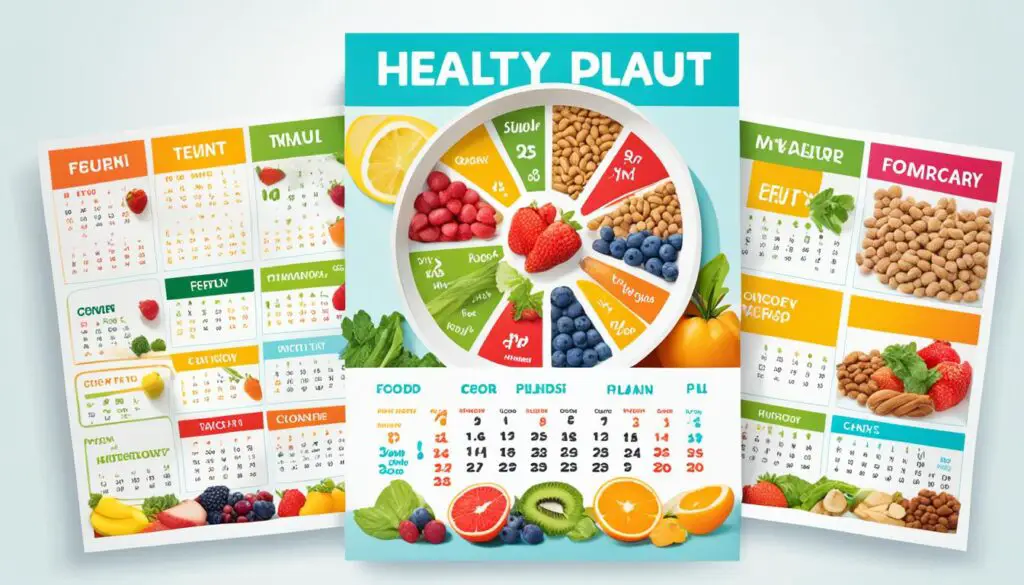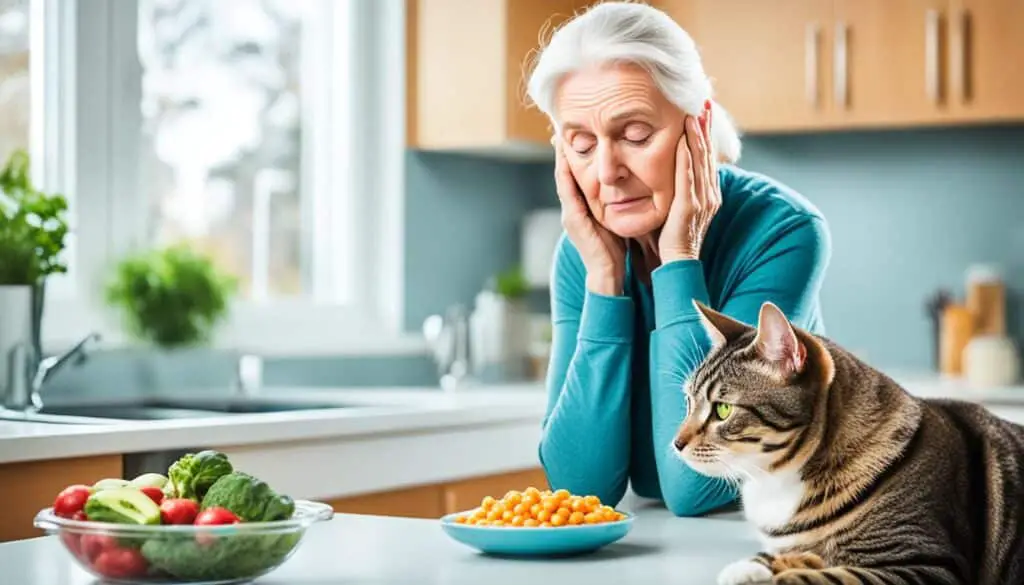Hey there, pet lovers! Want to see your pet’s health improve dramatically? It’s time to switch to a diet that’s full of nutrients. By choosing the right foods, you can boost your pet’s energy and health. Let’s dive into what makes a diet nutritious and pick the best options for our pets.
Key Takeaways:
- Feeding your pet a high-quality diet is crucial for their overall health and well-being.
- Choose pet foods that meet AAFCO standards and include a feeding trial on the label.
- Consider your pet’s life stage and specific dietary needs when selecting a food.
- Avoid boutique/exotic/grain-free diets, store brands like Ol’ Roy and Hill Country Fair, and improperly balanced homemade diets.
- Consult with your veterinarian for personalized feeding recommendations.
How to Properly Feed Your Pet
Feeding your pet is about more than just giving them food. It’s about keeping them healthy. A good feeding schedule and controlled portions help avoid obesity and provide the right nutrition. Let’s look at some tips for feeding your pet right:
- Begin with the food amount suggested on the package. But, adjust it according to your pet’s actual needs. Often, the suggested amounts are too high.
- For both young and adult pets, controlled feedings are best. Feed young pets under 3 months four times a day. Then, feed them three times a day until they reach 5 months. Adult pets should eat twice a day.
- Talk to a vet to figure out how much your pet should eat based on calories. This changes with their age, breed, activity, and health.
- Switch your pet’s food gradually to avoid upset stomachs. Follow the “1/4 every 4 days” rule. This means you mix in new food with old over 12 days.
- Don’t change your pet’s diet too often. It can upset their stomach. Keep their diet stable and slowly introduce new foods.
- If your pet has special health needs, they might need a unique diet. Always talk to your vet for advice on this.
Paying close attention to your pet’s feeding schedule, portion sizes, and diet changes is crucial. Follow these steps to ensure your pet stays healthy and happy.
Expert Tip:
“Consistency in feeding your pet is crucial. Having a regular routine prevents stomach problems and strengthens your bond with your pet.”
Next, let’s tackle the topic of grain-free and raw diets. Are they truly beneficial? We’ll explore this in our upcoming section.
The Truth about Grain-Free and Raw Diets
Grain-free diets have become popular for pets, with many owners thinking they’re better. But it’s key to know the truth about these diets, including the potential risks and downsides.
Grains are a good source of nutrition for pets, contrary to what some believe. Pets rarely have allergies to grains. They offer important vitamins, minerals, and fiber. Only a vet’s advice should lead to a grain-free diet for particular health issues.
Recent studies suggest a link between grain-free diets and a heart condition in dogs called dilated cardiomyopathy (DCM). The cause isn’t clear yet, but ingredients like legumes and potatoes might be factors. This risk hasn’t appeared in cats on grain-free diets.
For safety, dogs on grain-free diets might do better with grains in their meals. This change could lower the risk of DCM. It makes sure your pet gets a complete, nutritious diet.
Raw diets are another pet nutrition trend, but they have concerns too. These diets are claimed to be natural and suitable for pets. Yet, several risks are involved.
A big worry is the possible lack of balance in raw diets. It’s hard to ensure a diet has all needed nutrients when it’s raw. Too much or too little of certain nutrients can be harmful.
Raw diets can also expose pets to dangerous bacteria and parasites. Foods might contain harmful germs like Salmonella or E. coli. These can cause serious illnesses in pets and people.
Cooked food can be more digestible and safer for pets. Cooking kills harmful bacteria, making food better for them. Heating food improves safety and nutrient availability.
Cats, as obligate carnivores, have special dietary needs. They must have meat in their diet and can quickly become overweight if overfed. Wet and dry foods are good for cats and can be mixed. However, most cats can’t handle milk and might get stomach issues from it.
Grain-free and raw diets have become popular, but there are risks and downsides. Grain-free diets aren’t needed for most pets and might link to heart problems in dogs. Raw diets could lead to unbalanced nutrients and exposure to germs. Always talk to a vet about the best food choices for your pets.
The Risks and Drawbacks of Grain-Free and Raw Diets
To understand the risks of grain-free and raw diets, we need to look at key issues:
- Potential link between grain-free diets and dilated cardiomyopathy (DCM) in dogs
- Specific ingredients like legumes and potatoes associated with DCM
- Raw diets may lead to nutrient imbalances
- Risk of exposure to harmful bacteria and parasites in raw diets
- Potential for gastrointestinal issues and foodborne illnesses
- Milk can cause gastrointestinal problems in most cats
| Diets | Risks and Drawbacks |
|---|---|
| Grain-Free Diets | Potential link to DCM in dogs; unnecessary for most pets |
| Raw Diets | Nutrient imbalances; risk of exposure to harmful pathogens |
Understanding these risks helps pet owners make better diet choices for their friends. Always get advice from a veterinarian for feeding tips.
Conclusion
It’s really important to feed your pet a diet filled with nutrients. This ensures they stay healthy and happy. Making the right choices in food gives them the vital nutrients they need to flourish.
When picking pet food, search for high-quality products that stick to AAFCO standards and have gone through feeding trials. Think about your pet’s specific dietary needs and age to give them top-notch nutrition.
Keeping an eye on how much your pet eats and adjusting it as needed is crucial. Slowly switch them to new food to avoid upset stomachs. This helps them get used to their new meals safely.
Stay away from exotic, grain-free, and raw diets, unless a vet says otherwise. These diets can carry risks for your pet’s health. Cats need a diet rich in meat-based protein because of their unique biology.
Talk to your vet about what to feed your pet and how to handle any health issues. Choosing the right food is a big part of keeping your pet healthy. By giving them a diet full of nutrients, you help ensure they have a joyful and long life.
FAQ
What should I consider when choosing a pet food?
Look for pet food that meets AAFCO standards and includes a feeding trial on the label. It shows the food is right for your pet’s age and the nutrients are available.
Are expensive pet foods always better?
No, higher price doesn’t always mean better quality. Choose food based on its ingredients and nutrients, not just the price.
What brands of pet food are recommended?
Recommended brands include Science Diet, Royal Canin, Purina ProPlan, and Iams/Eukanuba. They’re known for their high-quality pet foods.
Should dogs and cats have different types of food?
Yes. Dogs and cats have different needs, so they need specific food. Feed them food made for their species.
How often should I feed my pet?
Puppies and kittens under 3 months should eat four times a day. This can decrease to three times daily between 3 and 5 months.
Adult dogs and cats should eat twice a day for a regular feeding schedule.
How much food should I give my pet?
Begin with the recommended amount on the food bag. Adjust it by watching your pet’s weight and health.
Bag recommendations often overestimate the needed amount.
How do I transition my pet to a new food?
Change food slowly to avoid upset stomachs. Increase new food and decrease old food over 12 days using the “1/4 every 4 days” rule.
Are grain-free and raw diets recommended for pets?
It’s usually best to avoid boutique/exotic/grain-free and raw diets. A vet should okay them first. These diets may not be nutritionally balanced.
What are the risks of feeding a raw diet to pets?
Raw diets can be risky. They might cause nutrient imbalance and expose pets to harmful pathogens. Cooked food is more digestible and reduces illness risks.
Do cats have unique dietary requirements?
Yes, cats need meat-based proteins. They’re obligate carnivores. Wet and dry foods can prevent obesity and add variety.
When should I consult with my veterinarian regarding my pet’s diet?
Always talk to your vet about your pet’s diet, especially for pets with medical issues. They can give advice tailored to your pet’s needs.



